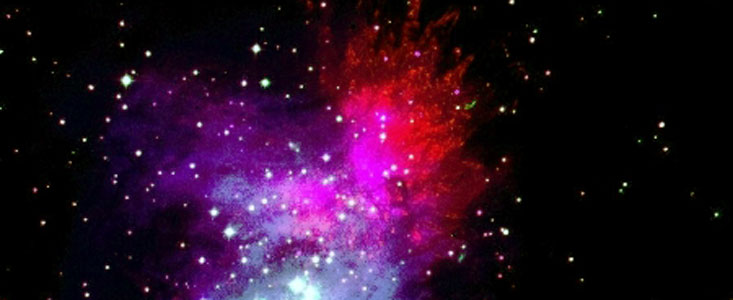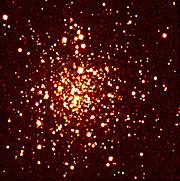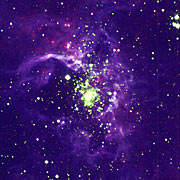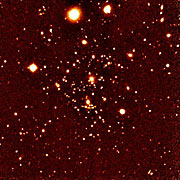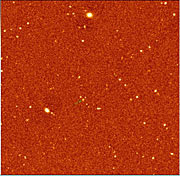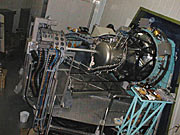Comunicato Stampa
Entering SOFI's Wonderful World
First Light for New Advanced Infrared Instrument at the NTT
29 Gennaio 1998
SOFI, ESO's new infrared imager/spectrometer, saw first light at the NTT telescope on December 6, 1997, as planned and less than two years after the start of its detailed design. The acronym stands for 'Son OF ISAAC', the larger Infrared Spectrometer And Array Camera being built by ESO for the VLT.
SOFI's power lies in its state-of-the-art, megapixel, array detector which is sensitive to infrared radiation at wavelengths between 1 and 2.5 microns, i.e. 2 to 5 times longer than that of normal visible light.
The Press Release is accompanied by a selection of the infrared images and spectra obtained during the first test which well illustrate the new level of excellence now offered by the SOFI/NTT combination. Not surprisingly, the competitive demand for access to this new facility is extremely high amongst Europe's astronomers.
Unusually short development time
Much development time for SOFI was saved by copying some of the technical solutions adopted for ISAAC and using the same detector acquisition system and control software.
In addition to delivering a new state-of-the-art instrument for the ESO La Silla Observatory, therefore, the project has also provided an important opportunity to test these critical elements at the newly upgraded NTT telescope prior to installation of the more complex ISAAC instrument at the VLT. Beyond the strictly instrumental aspects, this includes relatively novel operational features of the VLT such as the automatic execution of complex observation sequences via pre-prepared Observation Blocks and pipeline reduction and calibration of the data obtained.
Operational commissioning of these aspects of the system plus Science Verification Observations are planned to begin in March 1998 and the first Visiting Astronomers are already scheduled to use SOFI in June 1998.
SOFI: a multimode instrument of the new age
Optically, SOFI is a relatively complex instrument equipped with a variety of filters, grisms and polarizers which can be combined to yield several imaging and spectroscopic modes for different scientific investigations [1]. At its heart is the advanced 1024x1024 pixel infrared array detector (a Hg:Cd:Te array of the `Hawaii' type, developed by the Rockwell International Science Center), which has nearly 300 times more pixels and a factor of 100 less electronic noise than the detectors used in the first infrared astronomical cameras only a decade ago. It is also cosmetically exceptional (few 'bad' pixels) with the result that the quality of the infrared images is now approaching that obtained with CCD detectors in the visible.
ESO Press Photo eso9805 shows SOFI mounted at one of the Nasmyth foci of the NTT telescope. One of the complications of such instruments compared to those operating at visible wavelengths is that the optics and detector must be cooled to about -200 C o within a vacuum vessel and are therefore neither visible nor easily accessible.
Not all the data obtained during the test have yet been fully analyzed. Overall, however, the performance achieved appears to be very close to expectations [2]. They were obtained by ESO astronomers Alan Moorwood (PI), Jean-Gabriel Cuby (Instrument Scientist) and Chris Lidman (NTT Support Astronomer) during the SOFI tests.
Note
[1] Observational modes already implemented in SOFI include imaging in broad and narrow band filters with pixel scales between 0.29 and 0.075 arcsec/pixel and a maximum sky field of 5x5 arcmin; imaging polarimetry and low resolution (R about 600) spectroscopy using two grisms covering the 1-2.5 micron range. An additional medium resolution (R about 3500) spectroscopic mode is foreseen.
[2] For instance, the achieved point source sensitivity limits of J = 23, H = 22 and Ks = 21 mag (signal-to-noise ratio = 5 in 1 hour exposure for 0.75 arcsec seeing) were actually somewhat better than predicted.
Ulteriori Informazioni
More detailed information about SOFI will be found at the dedicated website (URL: http://www.eso.org/sci/facilities/lasilla/instruments/sofi/. The March 1998 issue of the ESO Messenger will contain a special section on the first SOFI results and the instrument itself.
Sul Comunicato Stampa
| Comunicato Stampa N": | eso9805 |
| Legacy ID: | PR 03/98 |
| Nome: | 30 Doradus, Abell 370, MRC 0406-244, NGC 1261, Orion Nebula, SOFI, Tarantula Nebula |
| Tipo: | Milky Way : Star : Grouping : Cluster : Globular Milky Way : Nebula : Type : Star Formation Local Universe : Nebula Early Universe : Galaxy Early Universe : Galaxy : Grouping : Cluster Unspecified : Technology : Observatory : Instrument |
| Facility: | New Technology Telescope |
| Instruments: | SOFI |
Our use of Cookies
We use cookies that are essential for accessing our websites and using our services. We also use cookies to analyse, measure and improve our websites’ performance, to enable content sharing via social media and to display media content hosted on third-party platforms.
ESO Cookies Policy
The European Organisation for Astronomical Research in the Southern Hemisphere (ESO) is the pre-eminent intergovernmental science and technology organisation in astronomy. It carries out an ambitious programme focused on the design, construction and operation of powerful ground-based observing facilities for astronomy.
This Cookies Policy is intended to provide clarity by outlining the cookies used on the ESO public websites, their functions, the options you have for controlling them, and the ways you can contact us for additional details.
What are cookies?
Cookies are small pieces of data stored on your device by websites you visit. They serve various purposes, such as remembering login credentials and preferences and enhance your browsing experience.
Categories of cookies we use
Essential cookies (always active): These cookies are strictly necessary for the proper functioning of our website. Without these cookies, the website cannot operate correctly, and certain services, such as logging in or accessing secure areas, may not be available; because they are essential for the website’s operation, they cannot be disabled.
Functional Cookies: These cookies enhance your browsing experience by enabling additional features and personalization, such as remembering your preferences and settings. While not strictly necessary for the website to function, they improve usability and convenience; these cookies are only placed if you provide your consent.
Analytics cookies: These cookies collect information about how visitors interact with our website, such as which pages are visited most often and how users navigate the site. This data helps us improve website performance, optimize content, and enhance the user experience; these cookies are only placed if you provide your consent. We use the following analytics cookies.
Matomo Cookies:
This website uses Matomo (formerly Piwik), an open source software which enables the statistical analysis of website visits. Matomo uses cookies (text files) which are saved on your computer and which allow us to analyze how you use our website. The website user information generated by the cookies will only be saved on the servers of our IT Department. We use this information to analyze www.eso.org visits and to prepare reports on website activities. These data will not be disclosed to third parties.
On behalf of ESO, Matomo will use this information for the purpose of evaluating your use of the website, compiling reports on website activity and providing other services relating to website activity and internet usage.
Matomo cookies settings:
Additional Third-party cookies on ESO websites: some of our pages display content from external providers, e.g. YouTube.
Such third-party services are outside of ESO control and may, at any time, change their terms of service, use of cookies, etc.
YouTube: Some videos on the ESO website are embedded from ESO’s official YouTube channel. We have enabled YouTube’s privacy-enhanced mode, meaning that no cookies are set unless the user actively clicks on the video to play it. Additionally, in this mode, YouTube does not store any personally identifiable cookie data for embedded video playbacks. For more details, please refer to YouTube’s embedding videos information page.
Cookies can also be classified based on the following elements.
Regarding the domain, there are:
- First-party cookies, set by the website you are currently visiting. They are stored by the same domain that you are browsing and are used to enhance your experience on that site;
- Third-party cookies, set by a domain other than the one you are currently visiting.
As for their duration, cookies can be:
- Browser-session cookies, which are deleted when the user closes the browser;
- Stored cookies, which stay on the user's device for a predetermined period of time.
How to manage cookies
Cookie settings: You can modify your cookie choices for the ESO webpages at any time by clicking on the link Cookie settings at the bottom of any page.
In your browser: If you wish to delete cookies or instruct your browser to delete or block cookies by default, please visit the help pages of your browser:
Please be aware that if you delete or decline cookies, certain functionalities of our website may be not be available and your browsing experience may be affected.
You can set most browsers to prevent any cookies being placed on your device, but you may then have to manually adjust some preferences every time you visit a site/page. And some services and functionalities may not work properly at all (e.g. profile logging-in, shop check out).
Updates to the ESO Cookies Policy
The ESO Cookies Policy may be subject to future updates, which will be made available on this page.
Additional information
For any queries related to cookies, please contact: pdprATesoDOTorg.
As ESO public webpages are managed by our Department of Communication, your questions will be dealt with the support of the said Department.
